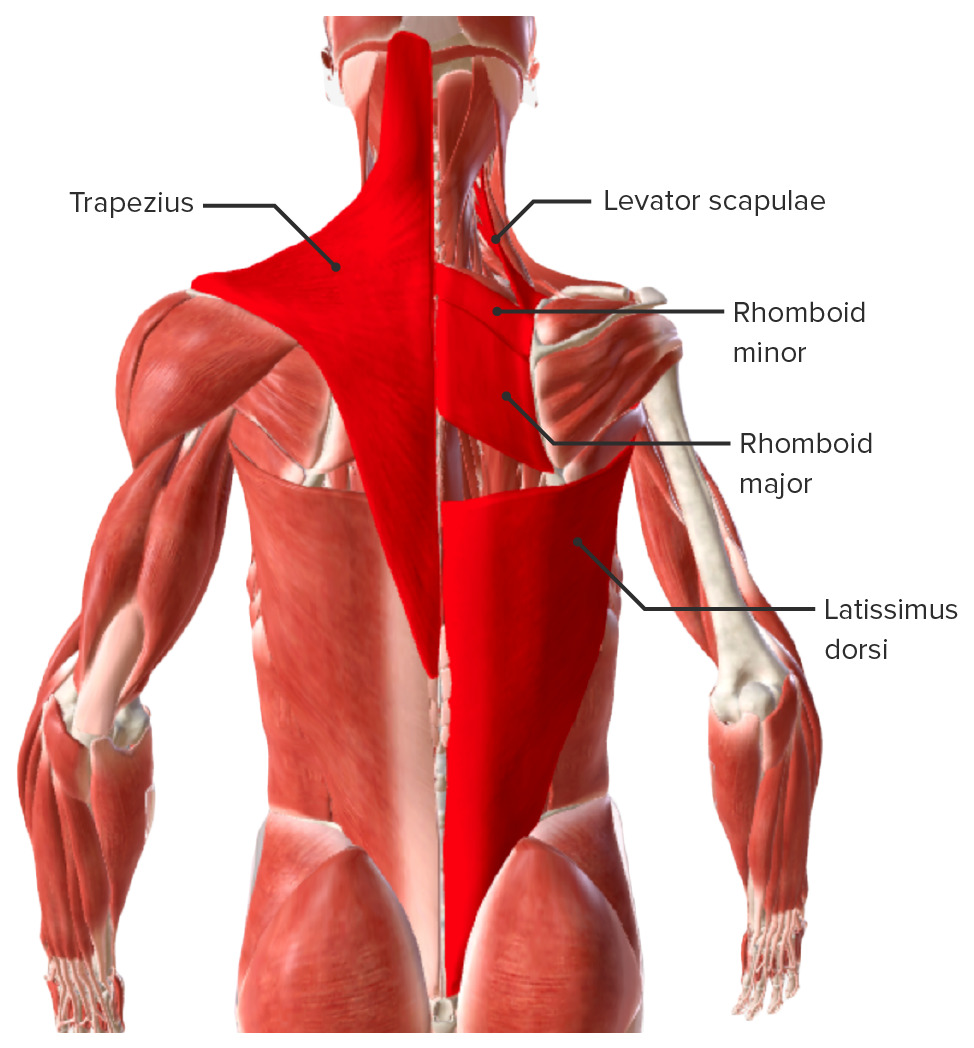Playlist
Show Playlist
Hide Playlist
Extrinsic Back Muscles
-
Slides Anatomy Extrinsic Back Muscles.pdf
-
Download Lecture Overview
00:01 Now let's talk about the muscles of the back, starting with the extrinsic back muscles. 00:07 The extrinsic back muscles are muscles that are located in the back, but actually don't have any action on the back itself but are actually muscles of the upper limb. 00:18 The superficial extrinsic muscles here are the trapezius, the latissimus dorsi, the levator scapulae and the rhomboid major and minor. 00:32 the trapezius has this triangular shape. 00:37 The begins at the base of the occipital bone at a bump called the occipital protuberance connects down the ligamentum nuchae down to the spinous processes from C7 to T12. 00:51 We look out laterally to where we see the spine of the scapula. 00:55 It's acromion and the lateral third of the clavicle. 01:01 The innervation of the trapezius is actually by cranial nerve 11 or the accessory nerve. 01:06 It's one of the two muscles. 01:08 The other being the sternocleidomastoid that the accessory nerve innervates. 01:14 Its function depends on which fibers are being contracted. 01:18 The upper fibers cause elevation of the scapula. 01:23 The middle fibers cause adduction of the scapula and the lower fibers cause depression of the scapula. 01:34 Next we'll look at this wide flat muscle of the back called the latissimus dorsi. 01:40 We see it has origins on the spine is processes of T7 to L5. 01:46 All the way down to the sacrum and parts of the pelvic bones called the iliac crest as well as the lower ribs 10 through 12. 01:56 And then they attach out on the upper limb at a little groove called the intertubercular sulcus of the humerus It's innervation is by the thoracodorsal nerve and its functions are multiple. 02:14 It has medial rotation or internal rotation of the humerus, adduction of the humerus, and extension of the humerus. 02:23 Typically this is the muscle thought of when it comes to rowing motions or performing a pull up. 02:32 Now we'll move to a smaller muscle called the levator scapulae. 02:37 And we can see that it has attachments to the transverse processes of the first four cervical vertebra And more distally we have the medial border of the scapula with a little bit of the superior angle of the scapula. 02:53 Its function as the name implies is elevation of the scapula hence the name levator scapulae. 03:02 Now, we'll look at the rhomboids together although they can be separated into a larger rhomboid major and a smaller rhomboid minor. 03:11 We see it has origins on the spinous processes of C7 to T1 as well as the spinous processes of T2 to T5 all the way to the medial border of the scapula. 03:25 And together their function is to retract the scapula. 03:30 The innervation of the rhomboids and levator scapula comes from the dorsal scapular nerve. 03:37 If we go a level inward, just a little bit deeper to those superficial muscles, we have the intermediate extrinsic muscles. 03:45 And we're looking posteriorly here at serratus posterior superior and serratus posterior inferior. 03:56 For serratus posterior superior, we have attachments from the spinous processes of C7 to T3 outer ribs 2 through 5. 04:06 And its innervation comes from the anterior rami of the upper thoracic nerves in this region And its function is to elevate these ribs 2 through 5. 04:18 Conversely, if we go down to serratus posterior inferior, we have attachments from the spinous processes of T11 to L3 to the lower ribs 9 through 12. 04:30 Its innervation is from the anterior rami of these lower thoracic nerves and its function is to depress ribs 9 through 12.
About the Lecture
The lecture Extrinsic Back Muscles by Darren Salmi, MD, MS is from the course Back Anatomy.
Included Quiz Questions
What is the origin of the trapezius?
- Occipital protuberance
- Spinous processes from C1 to T12
- Spine of scapula
- Clavicle
- Acromion
Which of the following is a function of the trapezius?
- Elevate the scapula
- Elevate the diaphragm
- Elevate the rhomboids
- Depress the rhomboids
- Depress the diaphragm
Which of the following is a function of the latissimus dorsi?
- Medial rotation of the humerus
- Lateral rotation of the humerus
- Abduction of the humerus
- Flexion of the humerus
- Elevation of the diaphragm
Customer reviews
5,0 of 5 stars
| 5 Stars |
|
5 |
| 4 Stars |
|
0 |
| 3 Stars |
|
0 |
| 2 Stars |
|
0 |
| 1 Star |
|
0 |




